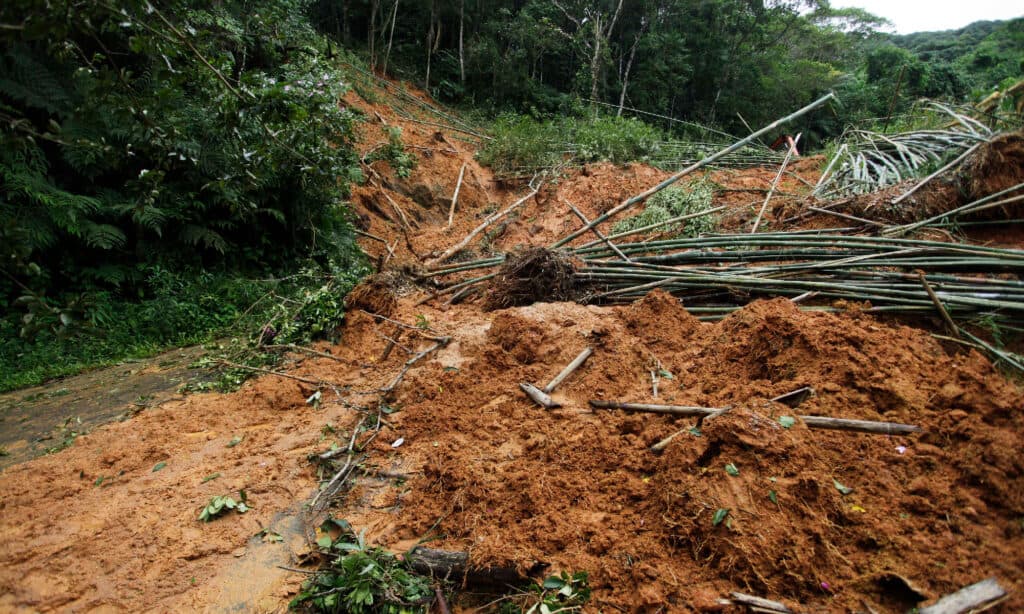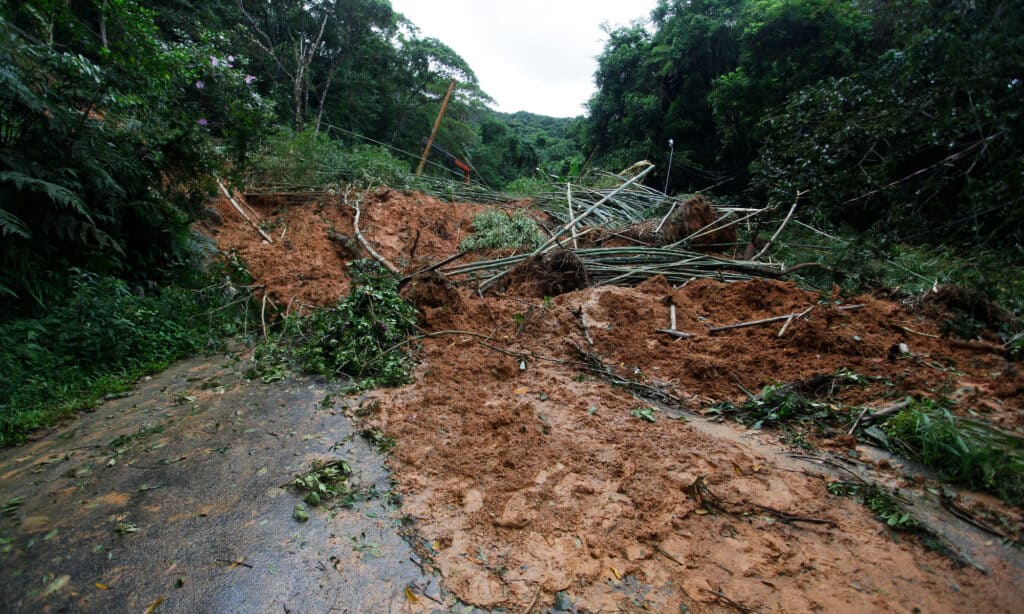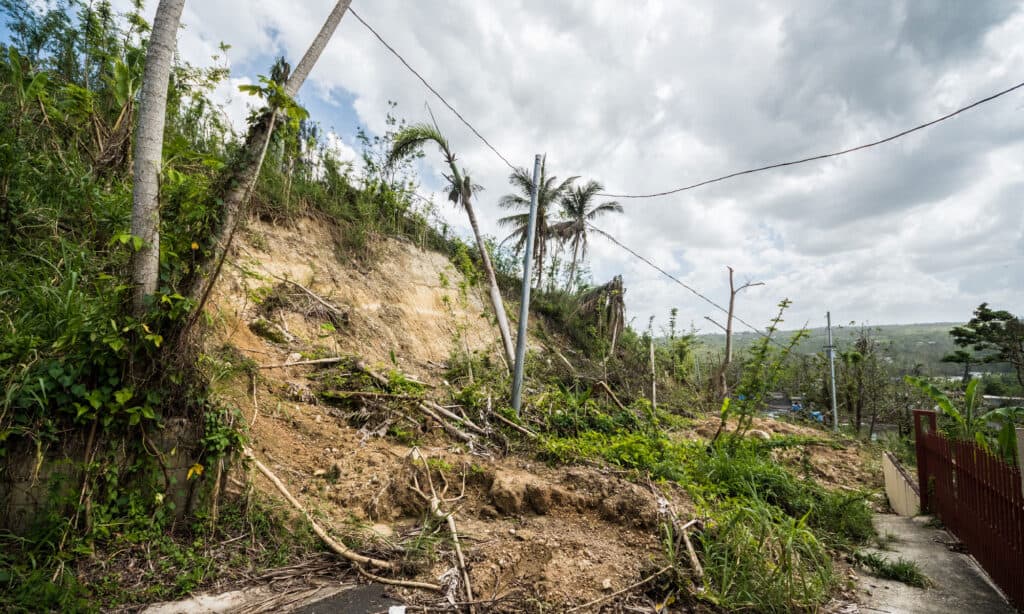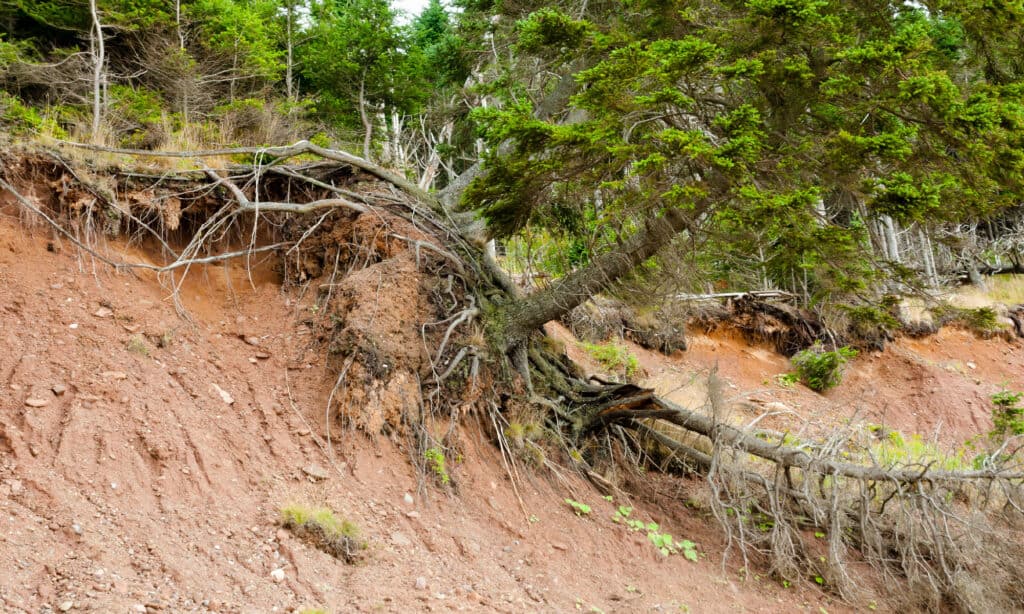Most naturally-occurring disasters have one thing in common: an adverse effect on human life, plants, animals, and even property. One of such natural hazards is mudslides. These typically occur in places with steep slopes or hillsides. Places like Washington, California, and Puerto Rico have experienced this many times.
The highest fatalities caused by mudslides have been recorded in the mountains of Asia and Central and South America. This disaster leaves a great deal of damage and is no good to life. Read on to learn more about mudslides, including how they can be prevented.
What is a Mudslide?

Mudslides are known as debris flows, indicating that they are a form of landslides.
©Nelson Antoine/Shutterstock.com
A mudslide is a mass movement of smooth materials, usually mud or heavily saturated soil, down a hill or steep slope. Mudslides are known as debris flows, indicating that they are a form of landslides. They usually look like a large flowing river of mud and sometimes branches, stones, or even human property like cars or houses.
How Do Mudslides Happen?

When large amounts of water accumulate to cause rapid soil erosion on a steep slope, mudslides happen.
©iStock.com/Svetlana123
Mudslides occur when large amounts of water accumulate to cause rapid soil erosion on a steep slope. When water soaks into the soil (as a result of heavy rain, for instance), it separates soil grains. When boulders and debris previously buried in the ground become dislodged, they could slip out and tumble downhill.
Over time, the saturated soil breaks free too, and the whole thing goes downhill rapidly. It is even easier for mudslides in gullies and other narrow passageways, making it convenient for the mud, rain, and debris combination to rush through.
Causes of Mudslides – Human Causes

Human activities, such as deforestation and wildfires, can indirectly cause mudslides.
©Nelson Antoine/Shutterstock.com
As much as mudslides are considered a natural disaster, human activities, such as deforestation and wildfires, can indirectly cause them .
Deforestation involves cutting down trees or burning forests, and it is a sure way to cause soil erosion. Soil erosion, in turn, loosens up the soil and its contents, making it easy for mudslides to happen after rainfalls. Other detrimental agricultural practices, such as planting on slopes or using pesticides, expose the soil and weaken it.
We set the stage for mudslides when we disregard cigarette butts carelessly, leave fires unattended to, or deliberately set uncontrolled fires. These human actions can multiply to cause wildland fires or allow them to grow unchecked and untethered. The result usually is that surrounding vegetation gets destroyed, the soil is exposed, and its aftermath is a deadly association of mud, rocks, or debris known as mudslides.
Causes of Mudslides – Natural Causes

Heavy rain can be a strong trigger for mudslides.
©iStock.com/Elmar Gubisch
As was mentioned earlier, heavy rain can be a strong trigger for mudslides. This is because the accumulated water alters the pressure within the slope, leading to instability. The rich soaked slope contents eventually yield to the forces of gravity, and there you have it – a mudslide.
Geological weathering and erosion are also significant triggers for mudslides. Over time, rocks disintegrate under the influence of water, acids, plants, temperature changes, and atmospheric forces. When erosion happens in areas with broken stones or boulders, bits of rock and minerals are swept away, resulting in a mudslide or other landslides.
Where Do Mudslides Happen the Most?

Areas, like California, Hawaii, and Washington, with heavy rainfalls are prone to mudslides.
©iStock.com/cestes001
Mudslides happen when the soil becomes overly saturated or watery, therefore unable to hold together on the earth’s surface. Thus, areas with heavy rainfalls are prone to mudslides. Such states include California, Hawaii, Alaska, Oregon, and Washington.
The most famous mudslides happened between 1967 and 2017, with estimated fatalities ranging from 200 to about 30,000 people. Asia, Central and South America, and parts of Africa were the most affected due to their types of terrain. Oso has also had its share of mudslides, although the degree is small compared to larger mudslides.
What Damages can Mudslides Cause?

Mudslides can destroy buildings that aren’t designed to withstand natural hazards.
©iStock.com/kiwisoul
The speed at which mudslides move, the debris, rocks, and trees they pull along, can be very harmful to the land. Vegetation will be destroyed, and the lands can be torn, leaving gullies. One upside is that rich nutrients will be transported to lower ground, leaving it more productive once the mudslide passes.
Mudslides can also destroy buildings that aren’t designed to withstand natural hazards, such as watersheds, stables, and farm structures. Infrastructure may also be destroyed where pipes, power and communication lines are damaged. Several lives have also been lost as a result of mudslides. When roads and communication resources are affected too, relief programs for affected people may be delayed.
When mudslides flow into rivers, they cannot continue the movement. As a result, the debris and other particles settle in the rivers and oceans, harming marine plants and animals and even the human population who rely on water sources.
How can Mudslides be Prevented or Avoided?

A way to prevent mudslides from happening is by planting vegetation.
©iStock.com/Adrian Wojcik
As we mentioned earlier, mudslides are usually preceded by events like heavy rains and wildfires. Therefore, it is best to stay informed on weather forecasts and the like for advance warnings of these events. Being aware of such predicted events can be a lifesaver if you live in a mudslide-prone area.
Another way to prevent mudslides from happening is by planting vegetation. Trees and shrubs make it hard for the flow of mud and wet earth to gather momentum. Vegetation also ensures that the soil isn’t left bare, and mudslides are kept to a bare minimum if they occur.
Since mudslides tend to flow in channels, channels and diversion barriers can be erected to ensure that the debris flow is directed away from homes and property.
Other Facts about Mudslides
- Periods or locations of future mudslides are hard to predict. This is due to varying soil compositions and geographic characteristics. However, there are known areas of risk, such as places that have been hit by mudslides before.
- Mudslides gather momentum the further they flow. When the flow proceeds downwards, it accelerates, gaining momentum and moving at incredible speeds. The speed of the debris flow can reach up to 35 miles per hour.
- Mudslides can travel great distances. Multiple debris flows can funnel into channels and eventually merge and gain volume as they progress, covering vast land areas.
- Mudslides can occur anytime in the year. Hillsides are vulnerable to mudslides for up to five years after a wildfire occurrence. The least amount of time it will take for vegetation to regrow and eliminate the risk of mudslides is about three to five years. During that period, repeat slides can happen, causing further devastating damage.
The photo featured at the top of this post is © Nelson Antoine/Shutterstock.com
Thank you for reading! Have some feedback for us? Contact the AZ Animals editorial team.







